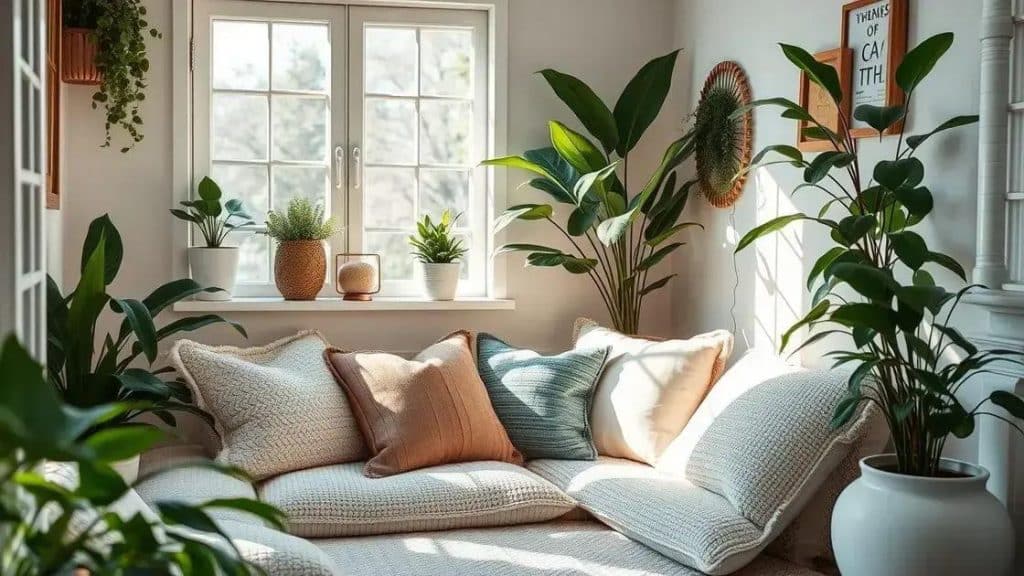Creating a Zen meditation corner for mindful tranquility

Creating a Zen meditation corner involves selecting a peaceful location, incorporating soft textures and natural elements, and maintaining a clutter-free space to enhance relaxation and mindfulness.
Creating a Zen meditation corner can enhance your mindfulness practice and offer a serene escape from daily stress. Have you ever considered how your environment influences your peace of mind? Let’s explore the essentials for crafting the perfect meditation nook.
Choosing the right location for your corner
Choosing the right location is essential when creating a Zen meditation corner. A well-selected spot can significantly enhance your meditation experience. Ideally, you want a space that feels calm and private, allowing you to escape the hustle of daily life.
Consider Natural Light
One important factor is natural light. Sunlight can uplift your spirit and help establish a positive atmosphere. When selecting your meditation corner, look for a location that receives gentle natural light without being too harsh.
Noise Levels Matter
Additionally, consider the noise levels in the area. Ideally, your meditation corner should be in a quiet space, free from distractions. Opt for a room away from busy streets or loud appliances.
- Look for corners with soft backgrounds.
- Avoid areas near the television or loud equipment.
- Consider the floor level: choose upstairs for less sound.
Don’t forget to think about how comfortable you feel in the chosen spot. This space should foster a sense of security and relaxation. Pay attention to any visual distractions nearby; if there are cluttered or chaotic surroundings, it might be better to rearrange or choose another spot.
Also, think about the temperature in the area. A comfortable setting is vital for effective meditation. You want a place that you won’t feel too hot or cold. Soft, calming colors around you can also create a sense of peace and tranquility.
Personal Preferences
Ultimately, your personal preferences should guide your choice as well. What locations make you feel at ease? Remember, this corner is for you. Whether it’s a nook by a window or a cozy corner filled with plants, your meditation spot should resonate with your unique style.
Essential elements for a calming atmosphere

To create a calming atmosphere in your Zen meditation corner, there are a few essential elements to consider. Each component plays a role in enhancing your relaxation and focus. The right setup can transport you to a peaceful state of mind.
Soft Textures
First, include soft textures in your space. Items like plush cushions and gentle blankets invite comfort. These materials can help you feel secure and relaxed, which is crucial during meditation.
Natural Elements
Incorporating nature is also vital. Plants, stones, and water features can enhance tranquility. The soothing presence of greenery not only beautifies the space but also encourages a connection to nature.
- Choose low-maintenance plants like succulents or peace lilies.
- Consider adding a small water fountain for calming sounds.
- Opt for decorative stones to incorporate a natural touch.
Lighting is another critical element. Warm, soft lighting can set the mood perfectly. Instead of bright overhead lights, consider using floor lamps or candles. These create a gentle glow that soothes the mind and prepares it for meditation. Remember, you can even use dimmers to control the intensity based on your mood.
Aromas That Calm
Aromatherapy can significantly influence your meditation experience. Using essential oils in a diffuser brings calming scents into your corner. Scents like lavender and sandalwood can help you relax deeply and focus your thoughts. A few drops can transform the atmosphere beautifully.
Incorporating nature and minimalism
Incorporating nature and minimalism is key to creating a Zen meditation corner. By blending natural elements with minimalist design, you create a peaceful environment that promotes relaxation and focus.
Natural Elements
Start with plants, which can bring life and energy to your space. Choose low-maintenance options such as snake plants or succulents, which thrive indoors. These plants add a touch of green, which studies show can help reduce stress and improve air quality.
Embrace Minimalism
Minimalism is about reducing clutter and distractions. Keep only essential items in your meditation corner. A few carefully selected pieces can create a sense of calm. Think of a simple mat, a cushion for comfort, and perhaps a small shelf for a few meaningful decorations.
- Limit decor to one or two meaningful items.
- Use neutral colors to soothe the eyes.
- Avoid overcrowding your space with furniture.
Balancing these elements is essential. Ensure that the plants don’t overwhelm your corner. Instead, they should complement the space, adding relaxation without chaos. A clean and organized corner allows your mind to settle and promote mindfulness more effectively.
Utilizing natural materials also enhances the calming effect. Consider wooden elements, such as a bamboo mat or a small wooden bench. These materials not only look beautiful but also connect you to nature, reinforcing that peaceful vibe.
Tips for maintaining your meditation space

Maintaining your meditation space is vital for ensuring it remains a sanctuary for peace and reflection. A clean and organized area helps foster a calming environment, making your meditation more effective.
Regular Cleaning
First, make it a habit to clean your corner regularly. Dusting the surfaces and rearranging items can refresh the space. This routine helps prevent clutter from building up, which can distract you during meditation.
Declutter Occasionally
Every once in a while, take a look at the items in your meditation corner. Ask yourself if each item still serves a purpose. If an object doesn’t inspire peace or mindfulness, consider removing it.
- Only keep items that promote calm.
- Rotate decor to keep the space feeling fresh.
- Consider seasonal changes for decor adjustments.
Another important aspect is to check the plants in your meditation corner. Ensure they are healthy and thriving, as they contribute to a tranquil atmosphere. If you notice any dying plants, replace or remove them to maintain a lively space.
Also, be mindful of scents in the area. Essential oils can attract dust and diminish scents over time. Cleaning your diffuser and checking your oils ensures your space remains aromatic and inviting.
Personal Touches
Finally, don’t hesitate to refresh your space with new elements that resonate with you. Adding new cushions or adjusting the light can greatly enhance your meditation practice. Keep the environment dynamic and engaging to inspire consistent use.
FAQ – Frequently Asked Questions about Creating a Zen Meditation Corner
What are the key elements to include in a Zen meditation corner?
Essential elements include soft textures, natural materials, plants, and calming colors that promote relaxation.
How do I maintain my meditation space effectively?
Regular cleaning, decluttering, and ensuring plants are healthy are vital for keeping your meditation corner serene.
Can I personalize my meditation corner?
Absolutely! Personal touches like meaningful decor and items that resonate with you enhance the space and make it feel special.
What types of plants are best for a meditation corner?
Low-maintenance plants like snake plants, succulents, or peace lilies are great choices, as they thrive indoors and help purify the air.





